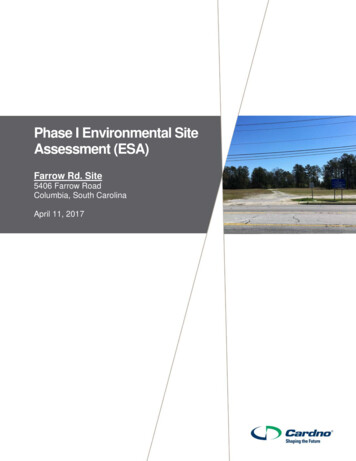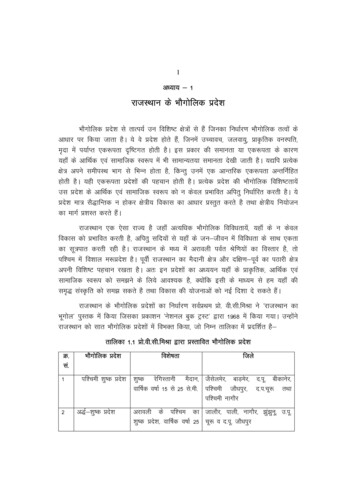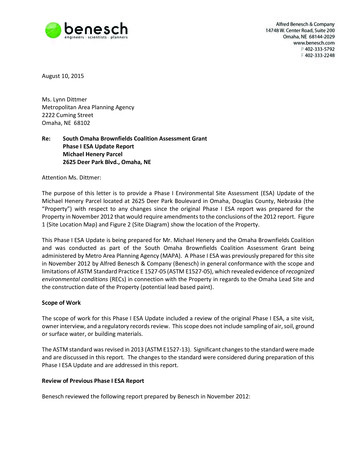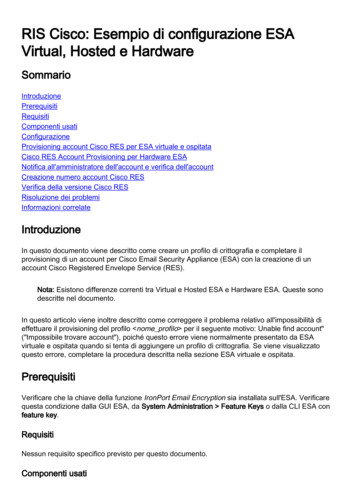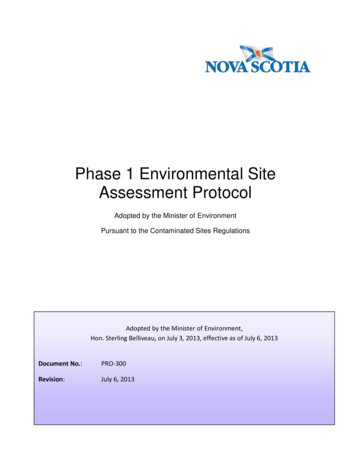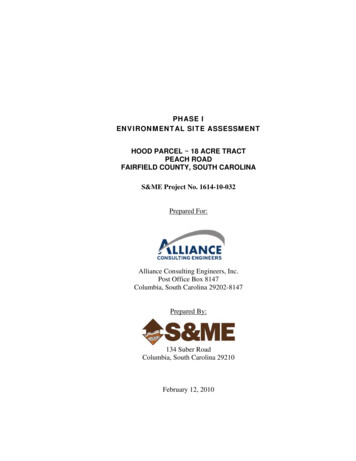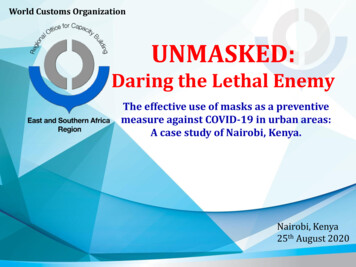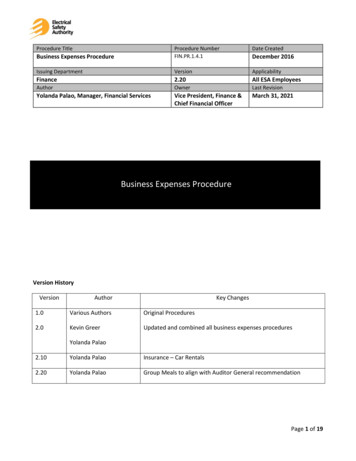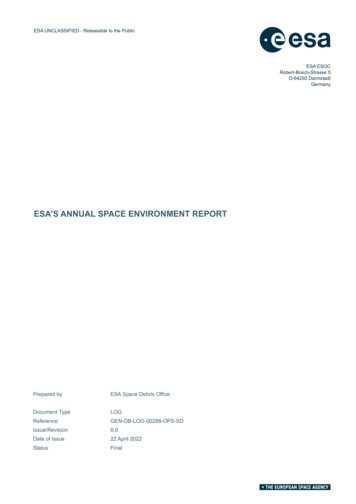
Transcription
ESA UNCLASSIFIED - Releasable to the PublicESA ESOCRobert-Bosch-Strasse 5D-64293 DarmstadtGermanyESA’S ANNUAL SPACE ENVIRONMENT REPORTPrepared byESA Space Debris OfficeDocument ion6.0Date of Issue22 April 2022StatusFinal
ESA UNCLASSIFIED - Releasable to the PublicTable of contentsExecutive summary . 31. Introduction . 91.1. Definitions . 101.2. Data sources . 121.3. Methodology . 131.4. Notable changes . 141.5. Acknowledgements . 151.6. Disclaimer . 162. Space Environmental History in Numbers . 172.1. Overall Space Environment . 182.2. Evolution of Environment in LEO . 222.3. Evolution of Environment in GEO . 242.4. Usage of the Protected Regions . 262.5. Constellations in the LEO protected region . 382.6. Active payloads in the LEO protected region . 392.7. New Catalogued Objects in the Space Environment. 432.8. Objects Removed from the Space Environment . 452.9. Nuclear Power Sources . 492.10.Registration of Objects Launched in Outer Space . 503. Environmental Status 2021 . 523.1. Status of the Environment in LEO . 553.2. Status of the Environment in GEO . 613.3. Fragmentations in 2021 . 633.4. Changes to the Environment in 2021 . 643.5. Conjunction statistics in LEO in 2021. 684. Intentional object release . 724.1. Mission Related Objects . 724.2. Solid Rocket Motor Firings . 745. Fragmentation History . 755.1. All fragmentation events . 775.2. Non-system related fragmentation events . 846. End-Of-Life Operations History . 866.1. End-Of-Life Operations in Low Earth Orbit . 866.2. End-Of-Life Operations in Geostationary Orbit . 1056.3. End-Of-Life Operations in MEO . 1107. Environment metrics . 1127.1. Environmental Index in 2021 . 1127.2. Environment evolution . 114References . 120Page 2/120
ESA UNCLASSIFIED - Releasable to the PublicEXECUTIVE SUMMARYEver since the start of the space age there has been more space debris in orbit than operational satellites. Asspace debris poses a problem for the near Earth environment on a global scale, only a globally supported solutioncan be the answer. This creates the need for a subset of internationally accepted space debris mitigation measures. A major step in this direction was taken in 2002, when the Inter-Agency Debris Committee (IADC) publishedits Space Debris Mitigation Guidelines. This document has since served as a baseline for non-binding policy documents, national legislation, and as a starting point for the derivation of technical standards. The standardisationof mitigation measures is important in order to achieve a common understanding of the required tasks leading totransparent and comparable processes. Even if having a consistent set of measures is paramount to tackle theglobal problem of space debris, it is still up to the individual nations, operators, and manufacturers to implementthem.In order to have on overview of the on-going global debris mitigation efforts and to raise awareness of spaceactivities in general, the European Space Agency, ESA, has been publishing a Space Environment Report since2017. The document is updated yearly, it is publicly available, and it supports the awareness raising guidelinelaid out in United Nations Committee on the Peaceful Uses of Outer Space’s (UNCOPUOS) Guidelines for theLong-Term Sustainability of Outer Space Activities published in 2019. The purpose of this report is to: Provide a transparent overview of global space activities; Estimate the impact of these activities on the space environment; Quantify the effect of internationally endorsed mitigation measures aimed at improving the sustainability ofspace flight.In this report, the status of the space environment is presented in various facets, focusing on the time evolution ofcatalogued and asserted objects in terms of number, mass, and area, as well as addressing the global adherenceto space debris mitigation measures. Most internationally accepted space debris mitigation measures can betraced back to the following objectives: The limitation of space debris released during normal operations;The minimisation of the potential for on-orbit break-ups;Post mission disposal;Prevention of on-orbit collisions.These objectives are translated in design and operation guidelines that can be measured and the consequencescan be assessed. Aspirationally, these objectives lead to future in which space debris is not an issue.Whereas the presentation of numerical values associated to launch and re-entry activities are essentially absolute, it is important to point out that metrics dealing with the adherence to space debris mitigation measures areestimates. These estimates depend on complex physical problems such as estimating orbital lifetime and requireunder-determined interpretations of observational quantities. As such the conclusions on the state of the spaceenvironment presented hereafter need to be taken with appropriate care and can vary between yearly releases ofthe report. Notwithstanding such caveats, all care is taken in the design of the methodologies to minimise suchvariability and some summarising statements can be derived from the presented data.Page 3/120
ESA UNCLASSIFIED - Releasable to the PublicThe amount of objects, their combined mass, and their combined area has been steadily rising since thebeginning of the space age, leading to the appearance of involuntary collisions between operational payloads andspace debris. Ever increasing improvements in space surveillance sensor capabilities during the last decadeshave brought down the size limits where debris can be reliably tracked and catalogued. This, in turn, implies thatwe know about significant amounts of space debris, but not all their originating events. The space traffic itselfis also undergoing notable changes since 2015, particularly in Low Earth Orbits, fuelled by the miniaturisationof space systems and deployment of large constellations, with a shift towards commercial operators. Thesethree elements (i.e. volume of traffic, type of spacecraft, type of operators) are all of relevance when one considersthe adequacy of space debris mitigation guidelines and possible ways for sustainable space operations, especiallywhen looking at the Earth’s orbital environment as a finite resource, in line with the UN Long-Term SustainabilityGuidelines [1]. ( Y R O X W L R Q L Q O O 2 U E L W V 8 , 5 0 5 ' 5 ) 5 % 2 E M H F W & R X Q W @ 3 0 3 ' 3 ) 3 / Q - D Q - D Q - D Q Q - D - D 5 H I H U H Q F H ( S R F K Q - D Q - DFigure 1: Evolution of number of objects in geocentric orbit by object class. Please consult Section 1.1 for thedefinitions. 3 D \ O R D G / D X Q F K 7 U D I I L F L Q W R & R P P X Q L F D W L R Q , P D J L Q J 6 S D F H V K L S 7 H F K Q R O R J \ 6 F L H Q F H 3 D \ O R D G / D X Q F K 7 U D I I L F L Q W R hp N P P N J N J P N J N J P N J P ! N J 1 X P E H U R I R E M H F W V @ 1 X P E H U R I 2 E M H F W V @ hp N P 1 D Y L J D W L R Q 6 L J L Q W & D O L E U D W L R Q : H D W K H U 2 W K H U / D X Q F K H D U / D X Q F K H D U Figure 2: Evolution of the launch traffic near LEOIADC per mission type (left) and mass category (right).Page 4/120
ESA UNCLASSIFIED - Releasable to the Public 1 X P E H U ) U D J P H Q W D W L R Q ( Y H Q W V 8 Q N Q R Z Q & R O O L V L R Q F F L G H Q W D O ( O H F W U L F D O H U R G \ Q D P L F V ' H O L E H U D W H Q R P D O R X V 3 U R S X O V L R Q 1 X P E H U ( Y H Q W H D U \ H D U E L Q V Figure 3: Historical trend of fragmentation events per event cause. The last bin covers untill the year 2021.On average over the last two decades, 11.7 non-deliberate fragmentations continue to occur in the space environment every year. This number is stable, however the impact of each event is variable. This number dropssignificantly to 2.6 per year when the lifetime of the generated fragments is considered a factor of importance,and even 0.3 per year when systematic and unexplained events are excluded from the analysis. This suggeststhat non-collisional events with a large environmental impact are still taking place partly due to re-use of a designwith known issues. Further details are presented in Table 5.1 and Table 5.2. Fragmentations other than collisionare currently the dominant source of space debris as can be seen from Figures 5.6 and 5.5. The increase in launchtraffic and permanence of space debris events in Low Earth orbit leads a significant conjunction risk in the mostcongested Earth orbits. Detailed information is given in Section 3.5. 8 Q N Q R Z Q 5 R F N H W ' H E U L V 5 R F N H W 0 L V V L R Q 5 H O D W H G 2 E M H F W 3 6 ) U D J P H Q W D W L R Q ' H E U L V 2 W K H U 5 R F N H W ) U D J P H Q W D W L R Q ' H E U L V 5 R F N H W % R G \ 3 D \ O R D G ' H E U L V 3 D \ O R D G 0 L V V L R Q 5 H O D W H G 2 E M H F W ) H Q J \ X Q & ) U D J P H Q W D W L R Q ' H E U L V & R V P R V ) U D J P H Q W D W L R Q ' H E U L V & R V P R V ) U D J P H Q W D W L R Q ' H E U L V , U L G L X P ) U D J P H Q W D W L R Q ' H E U L V 2 W K H U 3 D \ O R D G ) U D J P H Q W D W L R Q ' H E U L V & R Q V W H O O D W L R Q V 6 P D O O V D W H O O L W H V 2 W K H U 3 D \ O R D G 1 X P E H U R I F R Q M X Q F W L R Q H Y H Q W V K N P L K N P L K N P L K N P L K N P L K N P L K N P L Figure 4: Conjunction events (i.e. events that could trigger an operator response but not necessarily an avoidancemanoeuvre nor a collision) and corresponding chaser classification for a set of representative missions over 2021.Page 5/120
ESA UNCLASSIFIED - Releasable to the PublicAround 93% of small payloads, i.e. below 10.0 kg in mass, reaching the end of their mission during the lastdecade and injected into the LEO protected region operate in orbits that naturally adhere to the space debrismitigation measures. While this is a large fraction compared to higher mass categories, it still implies a growingcontingent of small payloads in need of active means to dispose themselves from the LEO protected region. Themajority of larger payloads reaching the end of their mission since 2010 did so in orbits where they did notsuccessfully removed themselves from.Between 30 and 70% of all payload mass, excluding human spaceflight, estimated as reaching end-of-life duringthe last decade in the LEO protected region does so in orbits that are estimated to adhere to the space debrismitigation measures, as shown in Fig. 6.4. The noted increase in small payloads reaching end-of-life in compliantorbit implies a rising share. Between 60 and 80% of all rocket body mass reaching end-of-life during the lastdecade does so in orbits that are estimated to adhere to the space debris mitigation measures on protectingLEO as shown in 6.6. A significant amount of this is due to controlled re-entries after launch, a practice whichincreased from 10% to over 40% over the last decade. / ( 2 F R P S O L D Q F H V 3 D \ O R D G V ( 2 / m N J / ( 2 F R P S O L D Q F H V 3 D \ O R D G V ( 2 / m N J & : 2 1 & : ) % & : 2 1 & : 2 1 & : 2 / ( 2 F R P S O L D Q F H V 3 D \ O R D G V ( 2 / m N J & : 7 % & : ) % / ( 2 F R P S O L D Q F H V 3 D \ O R D G V ( 2 / m N J & : 2 & : 2 & ' & : ) % 1 & : ) % 1 & : ) % 1 & : 2 & ' 1 & : 2Figure 5: Breakdown of the 2010 decade of observed behavioural classes for payloads per mass category. Pleaseconsult Section 6.1 for the definitions.Page 6/120
ESA UNCLASSIFIED - Releasable to the PublicOne of the core principles of the space debris mitigation guidelines is to remove objects from the LEO and GEOprotected regions with a high success rate for those orbits where a natural disposal mechanism is absent [2]. Inpractice, a common target for this success rate set at 90% based on space traffic condition corresponding to firstdecade of the millennium and with as goal to slow down the rate of space debris creation. It is thus a valuablefirst step towards space sustainability, but will by itself no reduce the amount of debris in orbit. Between 20 and50% of payloads, excluding human spaceflight, reaching end-of-life during the last decade in the LEO protectedregion in a non-compliant orbit attempt to comply with space debris mitigation measures, with peaks in 2018and 2020 respectively due to the de-orbiting of a constellation and a low amount of satellite reaching end of lifein a non-compliant orbit. The difference in behaviour between constellation and non-constellation objects can besignificant as shown in Fig. 6.3. Between 5% and 30%, again with peaks in 2018 and 2020 for the same reasons asbefore, do so successfully and a slight rising trend is noticeable. Between 40 and 90% of rocket bodies reachingend-of-life during the current decade in the LEO protected region in a non-compliant orbit attempt to comply withspace debris mitigation measures. Between 30% and 80% do so successfully, with the compliance trend linearlyincreasing. Between 40% and 50% of the rocket bodies delivering payloads in or near the GEO protectedregion during the last decade rare in compliance with space debris mitigation measures. Between 85% and100% of all payloads reaching end-of-life during the last decade in the GEO protected region attempt to complywith space debris mitigation measures. Between 60% and 90% do so successfully, with the compliance trendasymptotically increasing. 3 D \ O R D G V & O H D U D Q F H L Q / R Z ( D U W K 2 U E L W H [ O 1 D W X U D O O \ & R P S O L D Q W 3 D \ O R D G V 6 X F F H V V I X O W W H P S W , Q V X I I L F L H Q W W W H P S W 1 R W W H P S W 5 R F N H W % R G L H V & O H D U D Q F H L Q / R Z ( D U W K 2 U E L W H [ O 1 D W X U D O O \ & R P S O L D Q W 5 R F N H W % R G L H V 6 X F F H V V I X O W W H P S W , Q V X I I L F L H Q W W W H P S W 1 R W W H P S W ( 2 / \ H D U(a) Relative clearance of LEOIADC by payloads. ( 2 / \ H D U(b) Relative clearance of LEOIADC by rocket bodies. 3 D \ O R D G & O H D U D Q F H Q H D U * ( 2IADC 1 R W W H P S W , Q V X I I L F L H Q W W W H P S W 6 X F F H V V I X O W W H P S W & R X Q W @ & R X Q W V @ & R X Q W V @ ( Q G R I / L I H H D U (c) Relative clearance near GEOIADC by payloads.Figure 6: Trend of adherence to clearance of the protected region over time in terms of numbers, excluding naturallycompliant objects.Page 7/120
ESA UNCLASSIFIED - Releasable to the PublicWhereas adoption of, and compliance to, space debris mitigation practices at a global level is noted as slowlyincreasing, it is of importance to note that the successful implementation is still at a too low level to ensure asustainable environment in the long-run. Notably, some of the increase in uptake of mitigation measures asanalysed by the metrics above, such as controlled re-entries of rocket bodies or post mission disposal success ratesfor payloads in LEO, are linked with the deployment and retirement of large constellations. Other effects, suchas a shift in usage of operational mission orbits in Low Earth Orbit as show in Fig. 2.18, are however independentof the category of the payload. & X P X O D W L Y H Q X P E H U R I F D W D V W U R S K L F F R O O L V L R Q VThe extrapolation of the current changing use of orbits and launch traffic, combined with continued fragmentationsand limited post mission disposal success rate could lead to a cascade of collision events over the next centuries.Even in case of no further launches into orbit, it is expected that collisions among the space debris objects alreadypresent will lead to a further growth in space debris population. 1 R I X U W K H U O D X Q F K H V ( [ W U D S R O D W L R Q H D UFigure 7: Number of cumulative collisions in LEOIADC in the simulated scenarios of long-term evolution of theenvironment.Page 8/120
ESA UNCLASSIFIED - Releasable to the Public1. INTRODUCTIONEver since the start of the space age on the 4th of October 1957 there has been more space debris in orbit thanoperational satellites. Space debris poses a problem for the near Earth environment on a global scale, to whichall spacefaring nations have contributed and for which only a globally supported solution can be the answer. Thefirst awareness of the problem came about in the early 1960s, based on initial research activities undertaken in theUnited States of America, but it took some time to reach the international community. It eventually did by the mid1970s via conferences organised by the International Astronautical Federation. The effect whereby the generationof space debris via collisions and explosions in orbit could lead to an exponential increase in the amount of artificialobjects in space, in a chain reaction which would render spaceflight too hazardous to conduct, was first postulatedby Donald Kessler in 1978 [3]. The first dedicated conference on space debris was held in 1982, organised by theNational Aeronautics and Space Administration (NASA), followed by the first workshop on the re-entry of spacedebris in 1983, organised by the European Space Agency (ESA), in response to the re-entries of Skylab andCosmos-1402.The technical expertise on space debris, from re-entries to on-orbit break-up and hypervelocity impact testing, wasgathered on agency and national level for much of the 1970s and 1980s. However, the global dimension of theissue called for bilateral knowledge transfer, which started on the initiative of NASA. These exchanges betweenexperts resulted in multi-lateral meetings and lead to the creation of the Inter-Agency Space Debris CoordinationCommittee (IADC) in 1993, founded by ESA (Europe), NASA (USA), NASDA (now JAXA, Japan), and RSA (nowRoscosmos, Russian Federation). Nine more agencies have joined the IADC since: ASI (Italy), CNES (France),CNSA (China), CSA (Canada), DLR (Germany), KARI (South Korea), ISRO (India), NSAU (Ukraine), and UKSA(United Kingdom). The IADC was founded as a forum for technical exchange and coordination on space debrismatters, and can today be regarded as the leading international technical body in the field of space debris. Spacedebris has also been a recurring agenda item for the Scientific & Technical Subcommittee of the United Nations’Committee on the Peaceful Uses of Outer Space (UNCOPUOS) since 1994.The threat of space debris to the future of spaceflight combined with the nearly universal adoption of the LiabilityConvention [4] created the need for a set of internationally accepted space debris mitigation measures. A majorstep was taken in 2002, when the IADC published the IADC Space Debris Mitigation Guidelines [5] and presentedthem to the UNCOPUOS Scientific & Technical Subcommittee. This document has since served as baseline fornon-binding policy documents, national legislation, and as starting point for the derivation of technical standards.A consistent set of measures is paramount to tackle the global problem of space debris, but it is up to the individualnations, operators, and manufacturers to implement them, which can lead to variations on a case by case basis. Assuch, nations around the world have developed safety standards and specific guidelines building on the work of theIADC. However, standardisation of mitigation measures is important in order to achieve a common understandingof the required tasks leading to transparent and comparable processes. This is the task of normative internationalstandardisation bodies such as the International Standards Organisation (ISO) [6].In order to address the issues posed by space debris on spaceflight activities UNCOPUOS has taken the initiativeto create a set of internationally agreed guidelines for the long-term sustainability of outer space activities [1].These guidelines contain recommendations on the policy and regulatory frameworks for space activities, the safetyof space operations, rules of engagement for international cooperation, capacity-building and awareness, andscientific and technical research and development.Page 9/120
ESA UNCLASSIFIED - Releasable to the PublicThe content of this document is written in response to those guidelines by raising awareness of space activities,and aims to: Provide a transparent overview of global space activities, Estimate the impact of these activities on the space environment, And quantify the effect of internationally endorsed mitigation measures aimed at sustainability of the environment.The document is structured as follows: Section 1 contains the definitions, data sources, and methodologies usedto compile this document. Section 2 contains the history of the space environment since the beginning of the spaceage. Section 3 contains a snapshot of the space environment for a specific year analysed. The content of Sections2 and 3 are further analysed in depth in Sections 4, 5, and 6 where respectively the intentional release of objects,fragmentation events, and end-of-life operations of space missions are covered. Section 7 summarises the spaceactivities in Low Earth Orbit up until the year of analysis into an environment index. Furthermore, an executivesummary containing the main space environment trends identified is added to the beginning of this report.1.1. DefinitionsThis document aims to describe the space environment. This environment is understood to contain all artificialobjects, including fragments and elements thereof, which currently, or previously did, reside in an Earth boundorbit.The space environment will be described since the beginning of the space age, understood to start with the launchof Sputnik 1 on the 4th of October 1957, unless explicitly stated otherwise.Space debris is defined as all artificial objects including fragments and elements thereof, in Earth orbit or re-enteringthe atmosphere, that are non-functional [5].Objects in the space environment can be categorised in two broad categories: The ones which can be traced backto a launch event and for which the nature can be identified, and the ones for which this is impossible. The laterones will be identified as Unidentified, whereas the former can be further categorised in: Payloads, space object designed to perform a specific function in space excluding launch functionality. Thisincludes operational satellites as well as calibration objects. Payload mission related objects, space objects released as space debris which served a purpose for thefunctioning of a payload. Common examples include covers for optical instruments or astronaut tools. Payload fragmentation debris, space objects fragmented or unintentionally released from a payload as spacedebris for which their genesis can be traced back to a unique event. This class includes objects created whena payload explodes or when it collides with another object. Payload debris, space objects fragmented or unintentionally released from a payload as space debris forwhich the genesis is unclear but orbital or physical properties enable a correlation with a source. Rocket body, space object designed to perform launch related functionality; This includes the various orbitalstages of launch vehicles, but not payloads which release smaller payloads themselves. Rocket mission related objects, space objects intentionally released as space debris which served a purposefor the function of a rocket body. Common examples include shrouds and engines. Rocket fragmentation debris, space objects fragmented or unintentionally released from a rocket body asPage 10/120
ESA UNCLASSIFIED - Releasable to the Publicspace debris for which their genesis can be traced back to a unique event. This class includes objectscreated when a launch vehicle explodes. Rocket debris, space objects fragmented or unintentionally released from a rocket body as space debris forwhich the genesis is unclear but orbital or physical properties enable a correlation with a source.A fragmentation is thus loosely defined as an event on-orbit that creates space debris without purpose, includingbut not limited to collisions, explosive break-ups, and tear and wear. With this definition of a fragmentation event inmind, the distinction between mission related objects and fragmentations debris is clear. Objects that are classifiedas general payloads or rocket debris can be reclassified when more information becomes available. An overviewof this object type classification and the abbreviations used in the rest of the document is given in Table 1.1.The taxon
ESA'SANNUALSPACEENVIRONMENTREPORT Preparedby ESASpaceDebrisOffice DocumentType LOG Reference GEN-DB-LOG-00288-OPS-SD Issue/Revision 6.0 DateofIssue 22April2022 Status Final. ESAUNCLASSIFIED-ReleasabletothePublic Tableofcontents . report. 1.4.Notablechanges 1.4.1.Edition4

